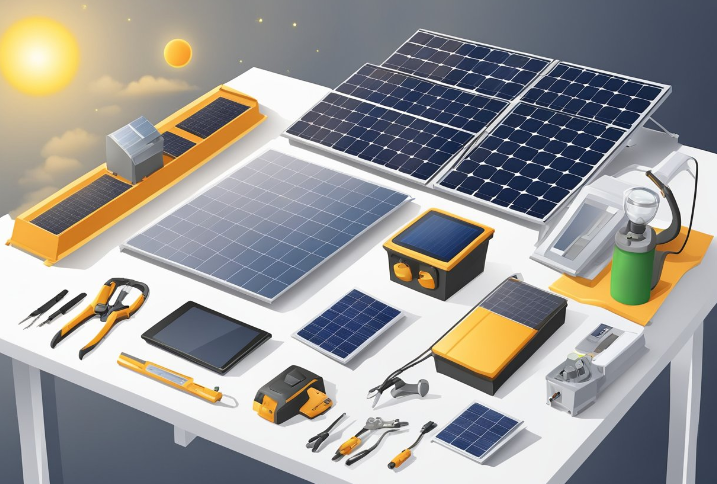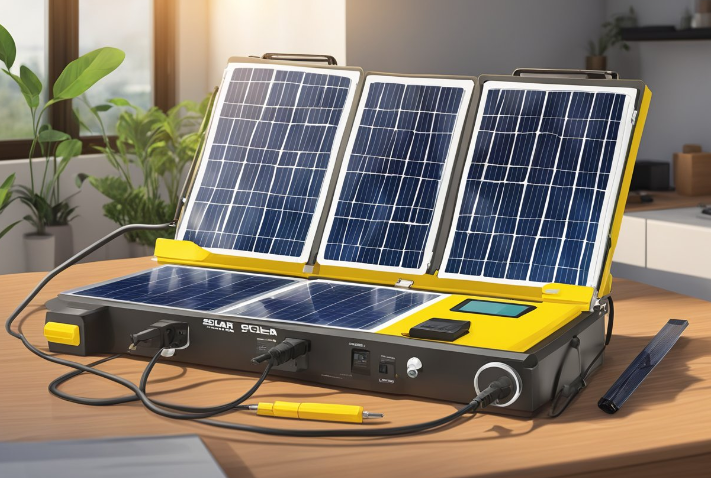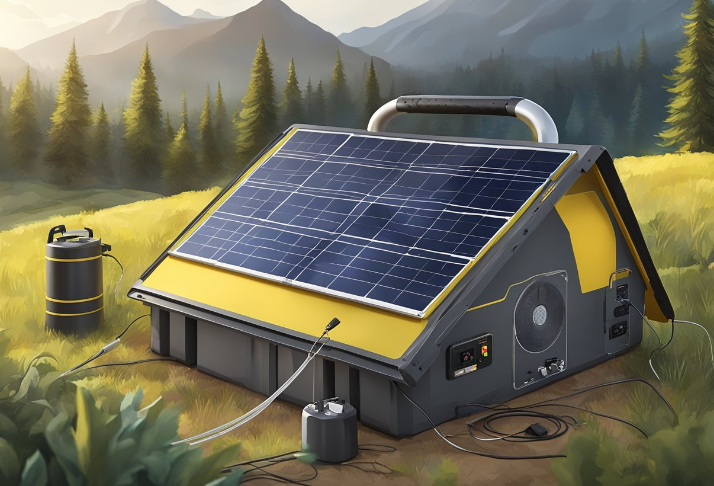DIY Solar Powered Portable Power Station Guide: Build Your Own Renewable Energy Source
Are you tired of being tethered to an outlet when you need power on the go? A DIY solar-powered portable power station may be the solution you're looking for. With a few components and some basic knowledge of solar power, you can build your own power station that harnesses the sun's energy to charge your devices, power small appliances, and even run power tools. Our DIY solar powered portable power station guide will help you navigate the world of portable power.

Understanding solar power is the first step in building your own solar-powered portable power station. Solar power is a renewable energy source that harnesses the sun's energy to create electricity. Solar panels collect sunlight and convert it into direct current (DC) electricity, which is then converted into alternating current (AC) electricity by an inverter. The electricity can then be stored in batteries for later use.
In this guide, we'll walk you through the components of a solar-powered portable power station, how to build your own, and maintenance and troubleshooting tips. We'll also answer some frequently asked questions about solar power and portable power stations. With this knowledge, you'll be able to build a portable power station that fits your needs and budget.
Key Takeaways
- Solar power is a renewable energy source that harnesses the sun's energy to create electricity.
- A solar-powered portable power station can provide power on the go without the need for an outlet.
- By understanding the components of a solar-powered portable power station and how to build and maintain one, you can create a power station that fits your needs and budget.
Understanding Solar Power

Basics of Solar Energy
Solar power is the conversion of energy from sunlight into electricity. It is a renewable source of energy that can be harnessed through the use of solar panels. Solar panels are made up of photovoltaic cells that convert sunlight into direct current (DC) electricity. This DC electricity is then converted into alternating current (AC) electricity through an inverter, which can be used to power homes, businesses, and other electrical devices.
Solar power systems can be either grid-tied or off-grid. Grid-tied systems are connected to the utility grid and allow excess electricity to be sold back to the utility company. Off-grid systems, on the other hand, are not connected to the utility grid and require battery storage to store excess electricity for later use.
Benefits of Solar Power
There are several benefits to using solar power. Firstly, it is a renewable source of energy that does not produce any harmful emissions. This makes it an environmentally friendly option for powering homes and businesses.
Secondly, solar power can help reduce electricity bills. By generating your own electricity, you can reduce your reliance on the grid and potentially save money on your monthly electricity bills.
Finally, solar power can increase the value of your property. According to a study by the National Renewable Energy Laboratory, homes with solar panels sell for more than those without. This means that investing in a solar power system can not only save you money on your electricity bills but can also increase the value of your property.
Overall, understanding the basics of solar energy and the benefits of solar power can help you make an informed decision about whether or not to invest in a solar power system.
Components of a Solar Powered Portable Power Station

A solar-powered portable power station is a self-contained system that converts solar energy into electrical energy. The system is made up of several components that work together to generate, store, and distribute power. Here are the main components of a solar-powered portable power station:
Solar Panels
The solar panels are the primary component of the system. They are responsible for converting solar energy into electrical energy. There are several types of solar panels available, including portable, rigid, and flexible solar panels. Portable solar panels are ideal for a portable power station as they are lightweight and easy to carry.
Battery Storage
The battery storage is where the electrical energy generated by the solar panels is stored. The battery is the heart of the system, and it determines how much power the system can produce and how long it can last. The battery capacity is measured in watt-hours (Wh) or ampere-hours (Ah). A higher capacity battery means more power can be stored and used later.
Inverter
The inverter is responsible for converting the DC (Direct Current) power generated by the solar panels and stored in the battery into AC (Alternating Current) power that can be used to power appliances and devices. The inverter also regulates the voltage and frequency of the power output to ensure that it is safe and stable.
Charge Controller
The charge controller regulates the charging of the battery. It ensures that the battery is not overcharged or undercharged, which can damage the battery and reduce its lifespan. The charge controller also prevents the battery from discharging too quickly, which can also damage the battery.
In summary, a solar-powered portable power station is a self-contained system that converts solar energy into electrical energy. The system is made up of several components, including solar panels, battery storage, inverter, and charge controller. Each component plays a critical role in generating, storing, and distributing power, and they must work together to ensure that the system functions correctly.
Building Your Own Solar Powered Portable Power Station
If you are interested in building your own solar-powered portable power station, there are a few things you need to consider. This section will guide you through the process of building your own solar-powered portable power station.
Choosing the Right Components
The first step in building your own solar-powered portable power station is to choose the right components. The most important components of a solar-powered portable power station are the solar panels, battery, charge controller, and inverter.
When choosing solar panels, you should consider the size of the panel, the power output, and the efficiency. The size of the panel will determine how much power it can generate, while the power output will determine how fast it can charge your battery. Efficiency will determine how well the panel can convert sunlight into electricity.
The battery is also an important component of a solar-powered portable power station. You should choose a battery with a high capacity and a long life. A deep cycle battery is recommended because it can be discharged and recharged many times without damaging the battery.
The charge controller is responsible for regulating the voltage and current from the solar panels to the battery. It prevents overcharging and over-discharging of the battery. You should choose a charge controller that matches the voltage and current of your solar panels and battery.
The inverter is responsible for converting the DC power from the battery into AC power that can be used to power your devices. You should choose an inverter that matches the power output of your battery and the devices you want to power.
Assembly Process
Once you have chosen the right components, the next step is to assemble them into a portable power station. The assembly process will depend on the specific components you have chosen, but here are the general steps:
- Mount the solar panels on a sturdy frame or surface that can be easily transported.
- Connect the solar panels to the charge controller using appropriate wiring.
- Then connect the charge controller to the battery using appropriate wiring.
- Connect the inverter to the battery using appropriate wiring.
- Test the system to make sure it is working properly.
Safety Measures
When building a solar-powered portable power station, it is important to take safety measures to prevent accidents and damage to the components. Here are some safety measures you should follow:
- Use appropriate wiring and connectors that are rated for the voltage and current of your system.
- Make sure all connections are tight and secure to prevent short circuits and electrical fires.
- Use protective gear such as gloves and safety glasses when handling the components.
- Keep the system away from water and other liquids to prevent damage to the components.
- Do not expose the system to extreme temperatures or direct sunlight for extended periods of time.
By following these guidelines, you can build your own solar-powered portable power station that can provide clean and sustainable energy for your outdoor adventures or emergency situations.
Maintenance and Troubleshooting
Routine Checks
To ensure that your DIY solar-powered portable power station is always ready to use, you should perform routine checks on a regular basis. Here are some of the things you should check:
- Battery level: Check the battery level and recharge it if necessary. You should also check the charging status to ensure that the battery is being charged properly.
- Solar panels: Inspect the solar panels for any damage or debris that may be blocking the sunlight. Clean the panels with a soft cloth and mild detergent if necessary.
- Cables and connectors: Check the cables and connectors for any signs of damage or wear. Replace any damaged cables or connectors immediately.
- Inverter: Check the inverter for any signs of damage or malfunction. Test the inverter to ensure that it is working properly.
Performing these routine checks will help you identify any potential issues before they become major problems.
Common Issues and Solutions
Despite your best efforts, you may encounter some issues with your DIY solar-powered portable power station. Here are some of the most common issues and their solutions:
- Battery not charging: If your battery is not charging, check the connections and cables to ensure that they are properly connected. You may also need to clean the battery terminals to improve the connection.
- Inverter not working: If your inverter is not working, check the connections and cables to ensure that they are properly connected. You may also need to reset the inverter by turning it off and then back on again.
- Solar panels not producing power: If your solar panels are not producing power, check for any damage or debris that may be blocking the sunlight. You may also need to adjust the angle of the panels to ensure that they are facing the sun.
- Overheating: If your DIY solar-powered portable power station is overheating, check the ventilation and cooling system to ensure that it is working properly. You may also need to move the power station to a cooler location.
By following these troubleshooting tips, you can quickly identify and resolve any issues with your DIY solar-powered portable power station.
Frequently Asked Questions
What are the parts needed to build a DIY solar generator?
To build a DIY solar generator, you will need a solar panel, a charge controller, a battery, an inverter, and some wiring. The solar panel will collect energy from the sun, and the charge controller will regulate the energy coming from the solar panel to the battery. The battery will store the energy, and the inverter will convert the stored energy into usable AC power.
How do I wire a DIY solar generator?
Wiring a DIY solar generator involves connecting the solar panel to the charge controller, the charge controller to the battery, and the battery to the inverter. You will also need to connect the inverter to the AC outlets and any other devices you want to power. It is important to follow the wiring diagram provided with your components to ensure proper connections and avoid damage to your equipment.
Can I charge a portable power station with a solar panel?
Yes, you can charge a portable power station with a solar panel. Most portable power stations come with a built-in charge controller and DC input, which allows you to plug in a solar panel and charge the battery. It is important to check the maximum input wattage and voltage of your power station and solar panel to ensure compatibility.
What is the difference between LiFePO4 and 18650 batteries for a DIY portable power station?
LiFePO4 batteries are more expensive than 18650 batteries, but they are more durable and have a longer lifespan. They are also safer and less prone to overheating or catching fire. 18650 batteries are more affordable and widely available, but they have a shorter lifespan and may require more maintenance.
Is it worth building a DIY portable solar power station?
Building a DIY portable solar power station can be a fun and rewarding project, but it may not be cost-effective for everyone. Depending on your energy needs and budget, it may be more practical to purchase a pre-made power station. However, building your own power station allows you to customize it to your specific needs and can be a great learning experience.
How do I build a 5000 watt solar generator?
Building a 5000 watt solar generator requires a larger solar panel array, a higher-capacity battery bank, and a larger inverter. It is important to size your components appropriately to ensure that they can handle the load. It is recommended to consult with a professional or do extensive research before attempting to build a solar generator of this size.
